sensor BMW 550I GT 2011 F07 User Guide
[x] Cancel search | Manufacturer: BMW, Model Year: 2011, Model line: 550I GT, Model: BMW 550I GT 2011 F07Pages: 297, PDF Size: 8.59 MB
Page 113 of 297
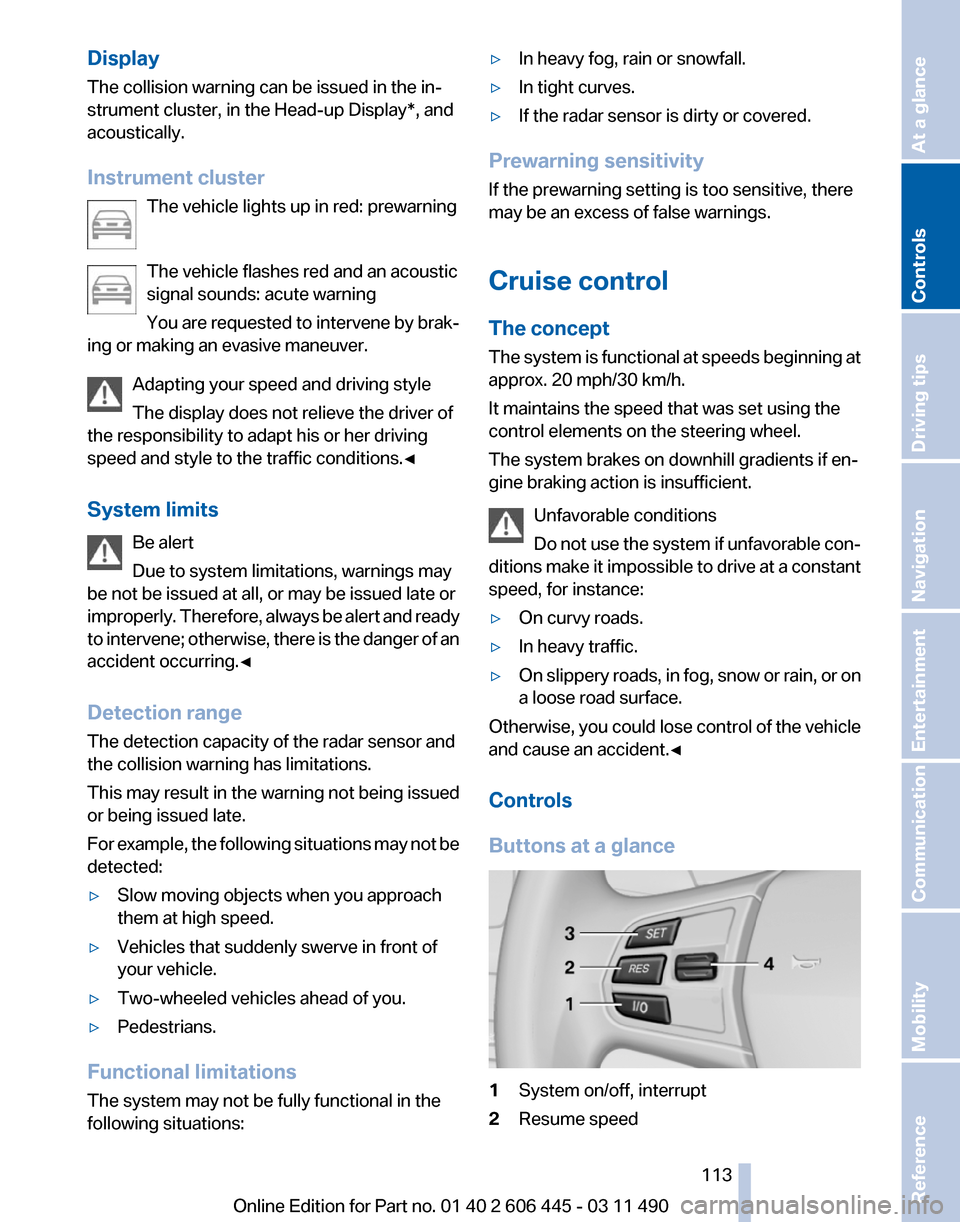
Display
The collision warning can be issued in the in‚Äê
strument cluster, in the Head-up Display*, and
acoustically.
Instrument cluster
The vehicle lights up in red: prewarning
The vehicle flashes red and an acoustic
signal sounds: acute warning
You
are requested to intervene by brak‚Äê
ing or making an evasive maneuver.
Adapting your speed and driving style
The display does not relieve the driver of
the responsibility to adapt his or her driving
speed and style to the traffic conditions.‚óÄ
System limits
Be alert
Due to system limitations, warnings may
be not be issued at all, or may be issued late or
improperly. Therefore, always be alert and ready
to intervene; otherwise, there is the danger of an
accident occurring.‚óÄ
Detection range
The detection capacity of the radar sensor and
the collision warning has limitations.
This may result in the warning not being issued
or being issued late.
For example, the following situations may not be
detected:
‚ñ∑ Slow moving objects when you approach
them at high speed.
‚ñ∑ Vehicles that suddenly swerve in front of
your vehicle.
‚ñ∑ Two-wheeled vehicles ahead of you.
‚ñ∑ Pedestrians.
Functional limitations
The system may not be fully functional in the
following situations: ‚ñ∑
In heavy fog, rain or snowfall.
‚ñ∑ In tight curves.
‚ñ∑ If the radar sensor is dirty or covered.
Prewarning sensitivity
If the prewarning setting is too sensitive, there
may be an excess of false warnings.
Cruise control
The concept
The
system is functional at speeds beginning at
approx. 20 mph/30 km/h.
It maintains the speed that was set using the
control elements on the steering wheel.
The system brakes on downhill gradients if en‚Äê
gine braking action is insufficient.
Unfavorable conditions
Do not use the system if unfavorable con‚Äê
ditions make it impossible to drive at a constant
speed, for instance:
‚ñ∑ On curvy roads.
‚ñ∑ In heavy traffic.
‚ñ∑ On slippery roads, in fog, snow or rain, or on
a loose road surface.
Otherwise, you could lose control of the vehicle
and cause an accident.‚óÄ
Controls
Buttons at a glance 1
System on/off, interrupt
2 Resume speed Seite 113
113Online Edition for Part no. 01 40 2 606 445 - 03 11 490
Reference Mobility Communication Entertainment Navigation Driving tips
Controls At a glance
Page 115 of 297
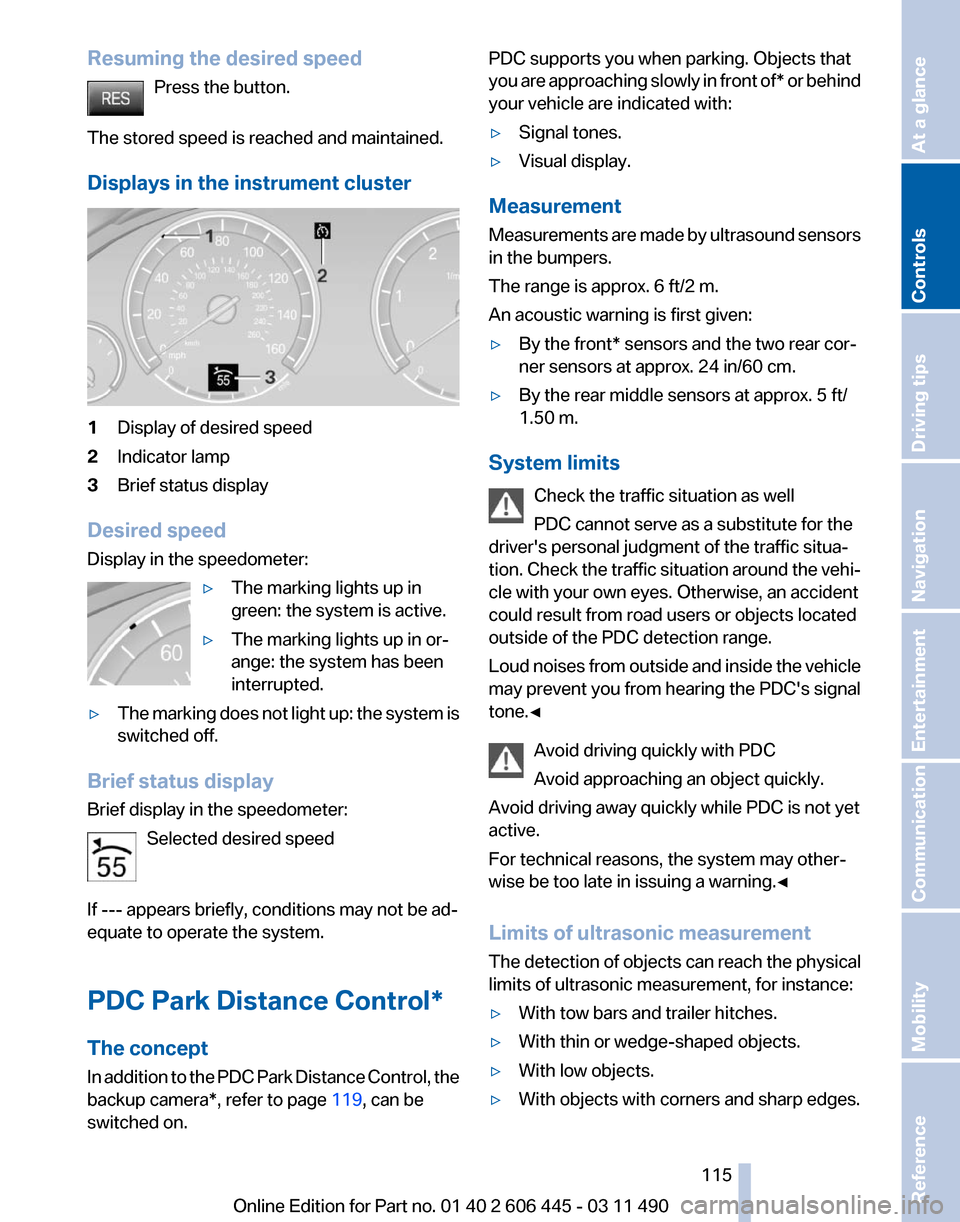
Resuming the desired speed
Press the button.
The stored speed is reached and maintained.
Displays in the instrument cluster 1
Display of desired speed
2 Indicator lamp
3 Brief status display
Desired speed
Display in the speedometer: ‚ñ∑The marking lights up in
green: the system is active.
‚ñ∑ The marking lights up in or‚Äê
ange: the system has been
interrupted.
‚ñ∑ The marking does not light up: the system is
switched off.
Brief status display
Brief display in the speedometer: Selected desired speed
If --- appears briefly, conditions may not be ad‚Äê
equate to operate the system.
PDC Park Distance Control*
The concept
In
addition to the PDC Park Distance Control, the
backup camera*, refer to page 119, can be
switched on. PDC supports you when parking. Objects that
you
are approaching slowly in front of* or behind
your vehicle are indicated with:
‚ñ∑ Signal tones.
‚ñ∑ Visual display.
Measurement
Measurements
are made by ultrasound sensors
in the bumpers.
The range is approx. 6 ft/2 m.
An acoustic warning is first given:
‚ñ∑ By the front* sensors and the two rear cor‚Äê
ner sensors at approx. 24 in/60 cm.
‚ñ∑ By the rear middle sensors at approx. 5 ft/
1.50 m.
System limits Check the traffic situation as well
PDC cannot serve as a substitute for the
driver's personal judgment of the traffic situa‚Äê
tion.
Check the traffic situation around the vehi‚Äê
cle with your own eyes. Otherwise, an accident
could result from road users or objects located
outside of the PDC detection range.
Loud noises from outside and inside the vehicle
may prevent you from hearing the PDC's signal
tone.‚óÄ
Avoid driving quickly with PDC
Avoid approaching an object quickly.
Avoid driving away quickly while PDC is not yet
active.
For technical reasons, the system may other‚Äê
wise be too late in issuing a warning.‚óÄ
Limits of ultrasonic measurement
The detection of objects can reach the physical
limits of ultrasonic measurement, for instance:
‚ñ∑ With tow bars and trailer hitches.
‚ñ∑ With thin or wedge-shaped objects.
‚ñ∑ With low objects.
‚ñ∑ With objects with corners and sharp edges. Seite 115
115Online Edition for Part no. 01 40 2 606 445 - 03 11 490
Reference Mobility Communication Entertainment Navigation Driving tips
Controls At a glance
Page 116 of 297
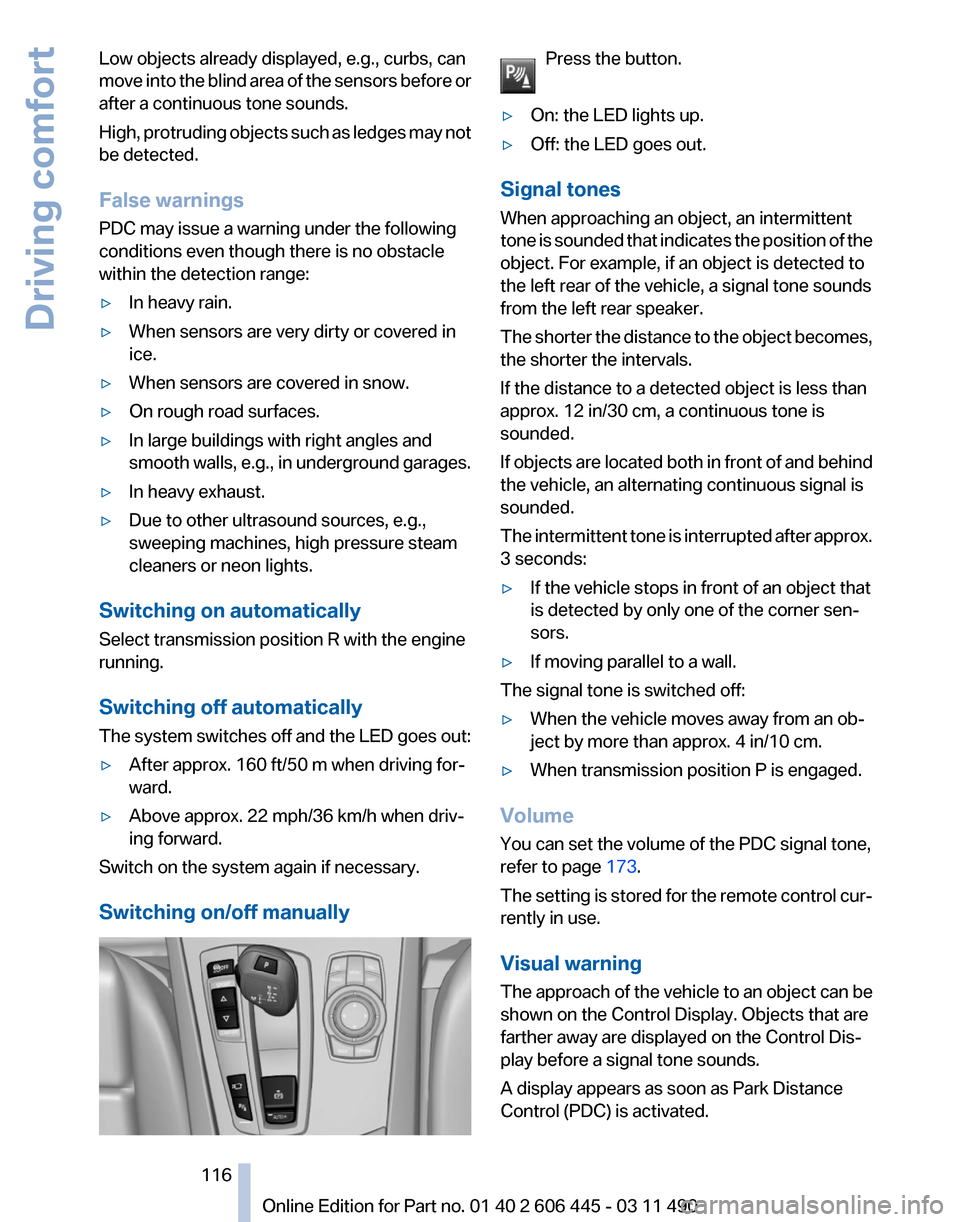
Low objects already displayed, e.g., curbs, can
move
into the blind area of the sensors before or
after a continuous tone sounds.
High, protruding objects such as ledges may not
be detected.
False warnings
PDC may issue a warning under the following
conditions even though there is no obstacle
within the detection range:
‚ñ∑ In heavy rain.
‚ñ∑ When sensors are very dirty or covered in
ice.
‚ñ∑ When sensors are covered in snow.
‚ñ∑ On rough road surfaces.
‚ñ∑ In large buildings with right angles and
smooth
walls, e.g., in underground garages.
‚ñ∑ In heavy exhaust.
‚ñ∑ Due to other ultrasound sources, e.g.,
sweeping machines, high pressure steam
cleaners or neon lights.
Switching on automatically
Select transmission position R with the engine
running.
Switching off automatically
The
system switches off and the LED goes out:
‚ñ∑ After approx. 160 ft/50 m when driving for‚Äê
ward.
‚ñ∑ Above approx. 22 mph/36 km/h when driv‚Äê
ing forward.
Switch on the system again if necessary.
Switching on/off manually Press the button.
‚ñ∑ On: the LED lights up.
‚ñ∑ Off: the LED goes out.
Signal tones
When approaching an object, an intermittent
tone
is sounded that indicates the position of the
object. For example, if an object is detected to
the left rear of the vehicle, a signal tone sounds
from the left rear speaker.
The shorter the distance to the object becomes,
the shorter the intervals.
If the distance to a detected object is less than
approx. 12 in/30 cm, a continuous tone is
sounded.
If objects are located both in front of and behind
the vehicle, an alternating continuous signal is
sounded.
The intermittent tone is interrupted after approx.
3 seconds:
‚ñ∑ If the vehicle stops in front of an object that
is detected by only one of the corner sen‚Äê
sors.
‚ñ∑ If moving parallel to a wall.
The signal tone is switched off:
‚ñ∑ When the vehicle moves away from an ob‚Äê
ject by more than approx. 4 in/10 cm.
‚ñ∑ When transmission position P is engaged.
Volume
You can set the volume of the PDC signal tone,
refer to page 173.
The
setting is stored for the remote control cur‚Äê
rently in use.
Visual warning
The approach of the vehicle to an object can be
shown on the Control Display. Objects that are
farther away are displayed on the Control Dis‚Äê
play before a signal tone sounds.
A display appears as soon as Park Distance
Control (PDC) is activated. Seite 116
116 Online Edition for Part no. 01 40 2 606 445 - 03 11 490
Driving comfort
Page 117 of 297
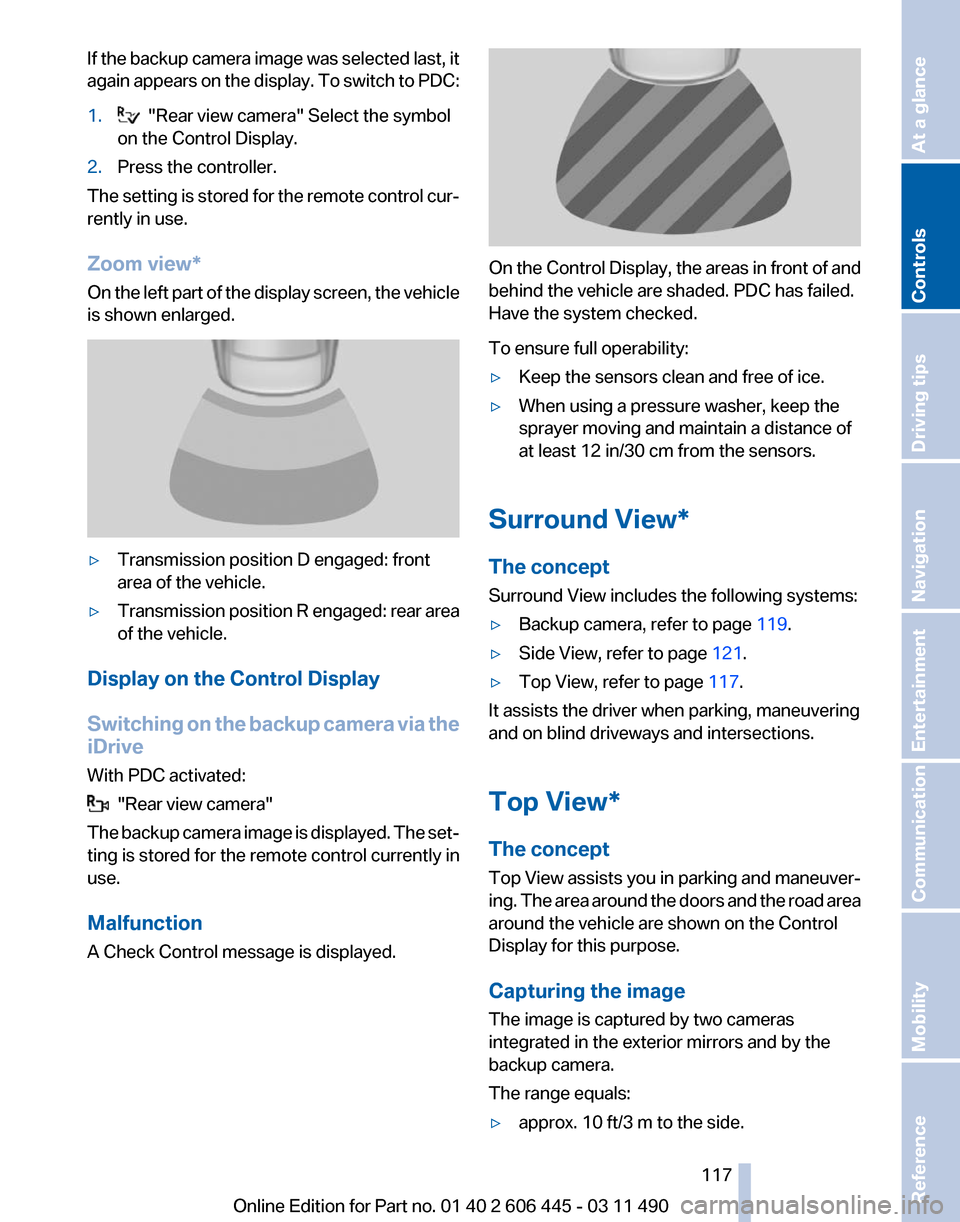
If the backup camera image was selected last, it
again
appears on the display. To switch to PDC:
1. "Rear view camera" Select the symbol
on the Control Display.
2. Press the controller.
The setting is stored for the remote control cur‚Äê
rently in use.
Zoom view*
On
the left part of the display screen, the vehicle
is shown enlarged. ‚ñ∑
Transmission position D engaged: front
area of the vehicle.
‚ñ∑ Transmission position R engaged: rear area
of the vehicle.
Display on the Control Display
Switching
on the backup camera via the
iDrive
With PDC activated: "Rear view camera"
The
backup camera image is displayed. The set‚Äê
ting is stored for the remote control currently in
use.
Malfunction
A Check Control message is displayed. On the Control Display, the areas in front of and
behind the vehicle are shaded. PDC has failed.
Have the system checked.
To ensure full operability:
‚ñ∑
Keep the sensors clean and free of ice.
‚ñ∑ When using a pressure washer, keep the
sprayer moving and maintain a distance of
at least 12 in/30 cm from the sensors.
Surround View*
The concept
Surround View includes the following systems:
‚ñ∑ Backup camera, refer to page 119.
‚ñ∑ Side View, refer to page 121.
‚ñ∑ Top View, refer to page 117.
It assists the driver when parking, maneuvering
and on blind driveways and intersections.
Top View*
The concept
Top
View assists you in parking and maneuver‚Äê
ing. The area around the doors and the road area
around the vehicle are shown on the Control
Display for this purpose.
Capturing the image
The image is captured by two cameras
integrated in the exterior mirrors and by the
backup camera.
The range equals:
‚ñ∑ approx. 10 ft/3 m to the side.
Seite 117
117Online Edition for Part no. 01 40 2 606 445 - 03 11 490
Reference Mobility Communication Entertainment Navigation Driving tips
Controls At a glance
Page 127 of 297

Climate control
Automatic climate control
*1
Air distribution, left
2 Temperature, left
3 AUTO program, left
4 Air volume, AUTO intensity, residual heat,
left
5 Remove ice and condensation
6 Maximum cooling
7 Display
8 Air volume, AUTO intensity, right
9 AUTO program, right
10 Temperature, right 11
Air distribution, right
12 Seat heating*, right‚ÄÇ‚ÄÖ 52
13 Active seat ventilation*, right‚ÄÇ‚ÄÖ52
14 Automatic recirculated-air control/recircu‚Äê
lated-air mode
15 Cooling function
16 Rear window defroster
17 ALL program
18 Active seat ventilation*, left‚ÄÇ‚ÄÖ52
19 Seat heating*, left‚ÄÇ‚ÄÖ 52
Climate control functions in detail
Manual air distribution Press the button repeatedly to select a
program:
‚ñ∑ Upper body region.
‚ñ∑ Upper body region and footwell. ‚ñ∑
Footwell.
‚ñ∑ Windows and footwell: driver's side only.
‚ñ∑ Windows, upper body region and footwell:
driver's side only.
If the windows are fogged over, press the AUTO
button
on the driver's side to utilize the conden‚Äê
sation sensor.
Seite 127
127Online Edition for Part no. 01 40 2 606 445 - 03 11 490
Reference Mobility Communication Entertainment Navigation Driving tips
Controls At a glance
Page 128 of 297
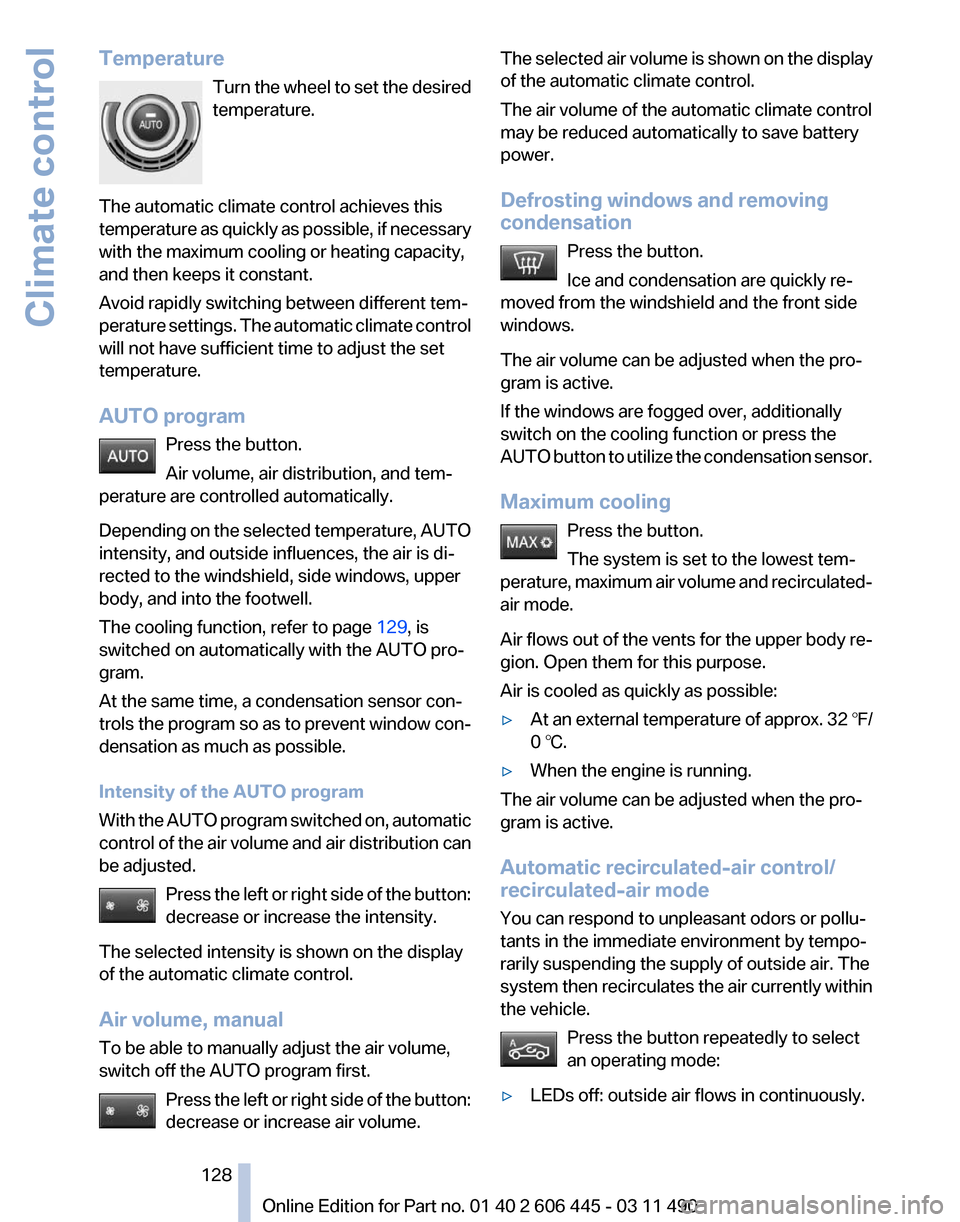
Temperature
Turn the wheel to set the desired
temperature.
The automatic climate control achieves this
temperature as quickly as possible, if necessary
with the maximum cooling or heating capacity,
and then keeps it constant.
Avoid rapidly switching between different tem‚Äê
perature settings. The automatic climate control
will not have sufficient time to adjust the set
temperature.
AUTO program Press the button.
Air volume, air distribution, and tem‚Äê
perature are controlled automatically.
Depending on the selected temperature, AUTO
intensity, and outside influences, the air is di‚Äê
rected to the windshield, side windows, upper
body, and into the footwell.
The cooling function, refer to page 129, is
switched on automatically with the AUTO pro‚Äê
gram.
At the same time, a condensation sensor con‚Äê
trols the program so as to prevent window con‚Äê
densation as much as possible.
Intensity of the AUTO program
With the AUTO program switched on, automatic
control of the air volume and air distribution can
be adjusted.
Press the left or right side of the button:
decrease or increase the intensity.
The selected intensity is shown on the display
of the automatic climate control.
Air volume, manual
To be able to manually adjust the air volume,
switch off the AUTO program first. Press the left or right side of the button:
decrease or increase air volume. The selected air volume is shown on the display
of the automatic climate control.
The air volume of the automatic climate control
may be reduced automatically to save battery
power.
Defrosting windows and removing
condensation
Press the button.
Ice and condensation are quickly re‚Äê
moved from the windshield and the front side
windows.
The air volume can be adjusted when the pro‚Äê
gram is active.
If the windows are fogged over, additionally
switch on the cooling function or press the
AUTO
button to utilize the condensation sensor.
Maximum cooling Press the button.
The system is set to the lowest tem‚Äê
perature, maximum air volume and recirculated-
air mode.
Air flows out of the vents for the upper body re‚Äê
gion. Open them for this purpose.
Air is cooled as quickly as possible:
‚ñ∑ At an external temperature of approx. 32 ‚Ñâ/
0 ‚ÑÉ.
‚ñ∑ When the engine is running.
The air volume can be adjusted when the pro‚Äê
gram is active.
Automatic recirculated-air control/
recirculated-air mode
You can respond to unpleasant odors or pollu‚Äê
tants in the immediate environment by tempo‚Äê
rarily suspending the supply of outside air. The
system
then recirculates the air currently within
the vehicle.
Press the button repeatedly to select
an operating mode:
‚ñ∑ LEDs off: outside air flows in continuously. Seite 128
128 Online Edition for Part no. 01 40 2 606 445 - 03 11 490
Climate control
Page 129 of 297
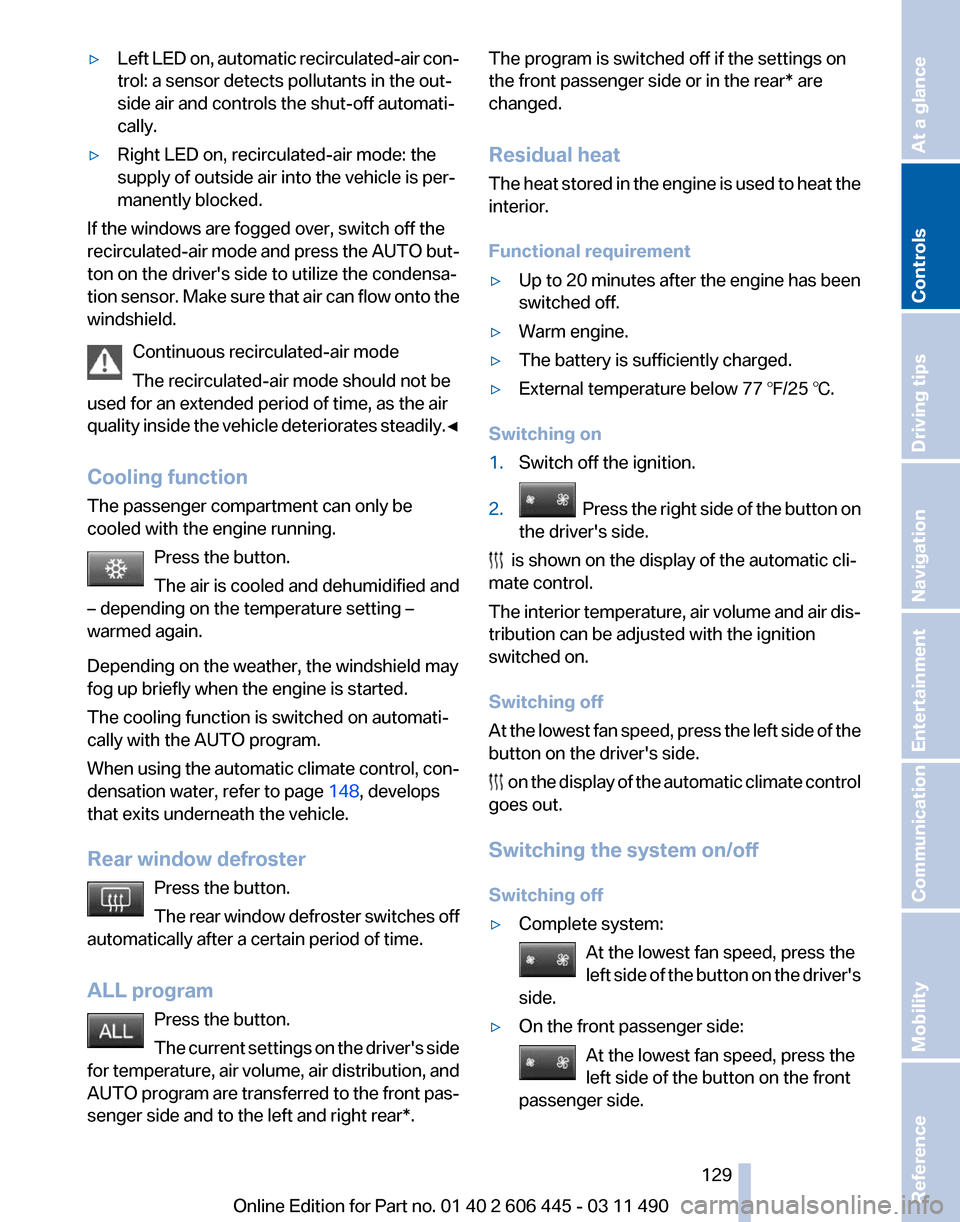
‚ñ∑
Left LED on, automatic recirculated-air con‚Äê
trol: a sensor detects pollutants in the out‚Äê
side air and controls the shut-off automati‚Äê
cally.
‚ñ∑ Right LED on, recirculated-air mode: the
supply of outside air into the vehicle is per‚Äê
manently blocked.
If the windows are fogged over, switch off the
recirculated-air mode and press the AUTO but‚Äê
ton on the driver's side to utilize the condensa‚Äê
tion sensor. Make sure that air can flow onto the
windshield.
Continuous recirculated-air mode
The recirculated-air mode should not be
used for an extended period of time, as the air
quality inside the vehicle deteriorates steadily.‚óÄ
Cooling function
The passenger compartment can only be
cooled with the engine running.
Press the button.
The air is cooled and dehumidified and
– depending on the temperature setting –
warmed again.
Depending on the weather, the windshield may
fog up briefly when the engine is started.
The cooling function is switched on automati‚Äê
cally with the AUTO program.
When using the automatic climate control, con‚Äê
densation water, refer to page 148, develops
that exits underneath the vehicle.
Rear window defroster
Press the button.
The rear window defroster switches off
automatically after a certain period of time.
ALL program
Press the button.
The current settings on the driver's side
for temperature, air volume, air distribution, and
AUTO program are transferred to the front pas‚Äê
senger side and to the left and right rear*. The program is switched off if the settings on
the front passenger side or in the rear* are
changed.
Residual heat
The
heat stored in the engine is used to heat the
interior.
Functional requirement
‚ñ∑ Up to 20 minutes after the engine has been
switched off.
‚ñ∑ Warm engine.
‚ñ∑ The battery is sufficiently charged.
‚ñ∑ External temperature below 77 ‚Ñâ/25 ‚ÑÉ.
Switching on
1. Switch off the ignition.
2. Press the right side of the button on
the driver's side. is shown on the display of the automatic cli‚Äê
mate control.
The
interior temperature, air volume and air dis‚Äê
tribution can be adjusted with the ignition
switched on.
Switching off
At the lowest fan speed, press the left side of the
button on the driver's side. on the display of the automatic climate control
goes out.
Switching the system on/off
Switching off
‚ñ∑ Complete system:
At the lowest fan speed, press the
left
side of the button on the driver's
side. ‚ñ∑
On the front passenger side:
At the lowest fan speed, press the
left side of the button on the front
passenger side. Seite 129
129Online Edition for Part no. 01 40 2 606 445 - 03 11 490
Reference Mobility Communication Entertainment Navigation Driving tips
Controls At a glance
Page 154 of 297
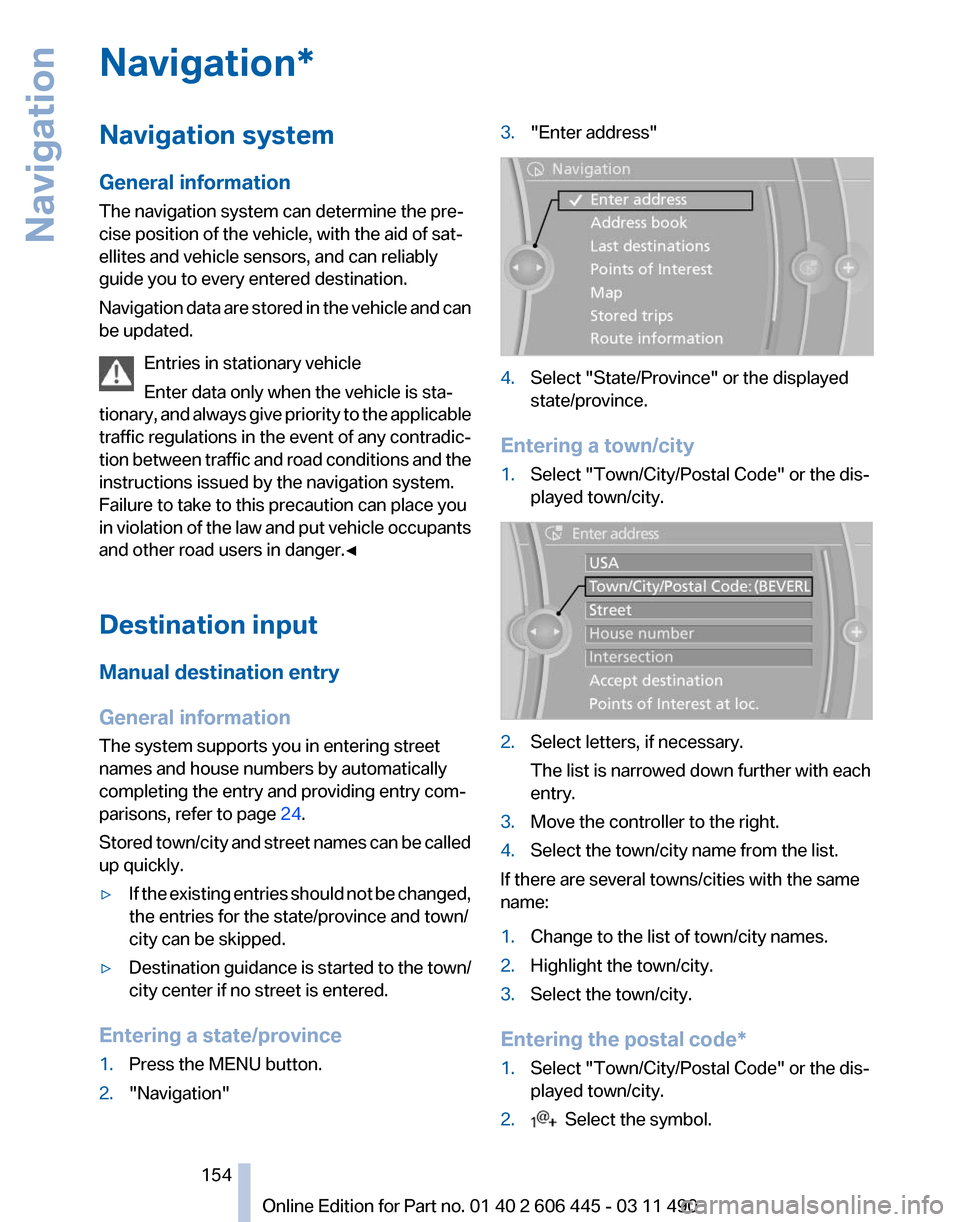
Navigation*
Navigation system
General information
The navigation system can determine the pre‚Äê
cise position of the vehicle, with the aid of sat‚Äê
ellites and vehicle sensors, and can reliably
guide you to every entered destination.
Navigation
data are stored in the vehicle and can
be updated.
Entries in stationary vehicle
Enter data only when the vehicle is sta‚Äê
tionary, and always give priority to the applicable
traffic regulations in the event of any contradic‚Äê
tion between traffic and road conditions and the
instructions issued by the navigation system.
Failure to take to this precaution can place you
in violation of the law and put vehicle occupants
and other road users in danger.‚óÄ
Destination input
Manual destination entry
General information
The system supports you in entering street
names and house numbers by automatically
completing the entry and providing entry com‚Äê
parisons, refer to page 24.
Stored town/city and street names can be called
up quickly.
‚ñ∑ If the existing entries should not be changed,
the entries for the state/province and town/
city can be skipped.
‚ñ∑ Destination guidance is started to the town/
city center if no street is entered.
Entering a state/province
1. Press the MENU button.
2. "Navigation" 3.
"Enter address" 4.
Select "State/Province" or the displayed
state/province.
Entering a town/city
1. Select "Town/City/Postal Code" or the dis‚Äê
played town/city. 2.
Select letters, if necessary.
The list is narrowed down further with each
entry.
3. Move the controller to the right.
4. Select the town/city name from the list.
If there are several towns/cities with the same
name:
1. Change to the list of town/city names.
2. Highlight the town/city.
3. Select the town/city.
Entering the postal code*
1. Select "Town/City/Postal Code" or the dis‚Äê
played town/city.
2. Select the symbol.
Seite 154
154 Online Edition for Part no. 01 40 2 606 445 - 03 11 490
Navigation
Page 201 of 297

Rear entertainment*
Controls
1
Screen, left
2 Screen, right
3 Center armrest, remote control
4 CD/DVD player
Rear CD/DVD player 1
CD/DVD slot
2 Eject CD/DVD
3 On/off, right
4 Headphone connection, right
5 RCA sockets
6 Headphone connection, left
7 On/off, left
Switching the system on/off Press the left or right side of the button
on the CD/DVD player in the rear for the
respective page. Rear entertainment and screens are switched
on/off.
After
switching off the ignition, the system must
be switched on again.
Screens
Adjusting
Danger of burns when screen is folded out
Do not reach behind the screen; other‚Äê
wise, there is the danger of getting burned. The
back of the screen can become very hot.‚óÄ ‚ñ∑
To fold out: pull at the bottom edge.
‚ñ∑ To fold in: press against the bottom edge.
Notes
‚ñ∑ Do not cover lower screen edge, since this
is where the sensors and the infrared inter‚Äê
face are installed.
‚ñ∑ When loading the rear seats and adjusting
the backrest of the front seat, fold in the
screens.
‚ñ∑ When using the through-loading system,
fold the screens down.
‚ñ∑ When cleaning the screen, follow the care
instructions, refer to page 271. Seite 201
201Online Edition for Part no. 01 40 2 606 445 - 03 11 490
Reference Mobility Communication
Entertainment Navigation Driving tips Controls At a glance
Page 256 of 297
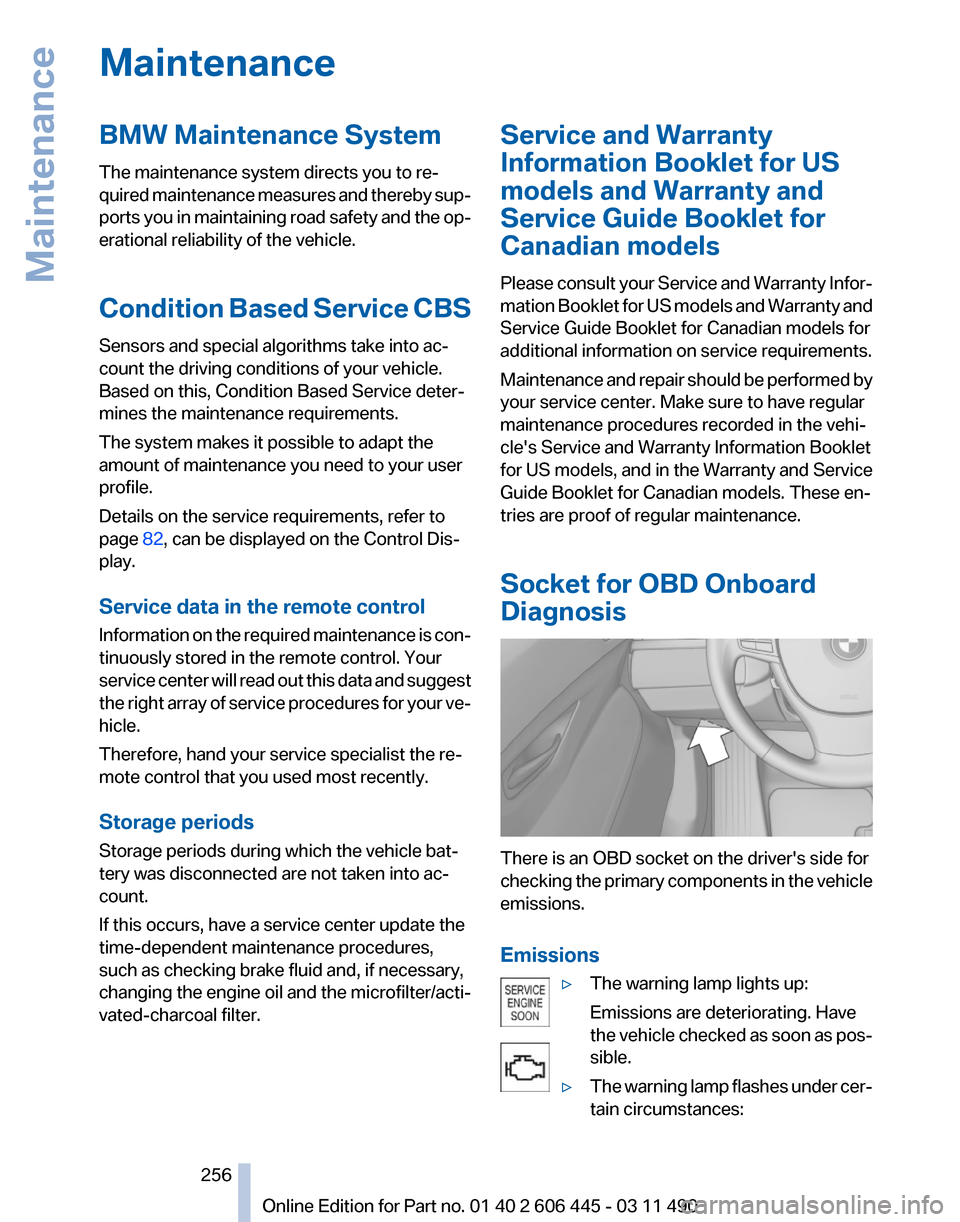
Maintenance
BMW Maintenance System
The maintenance system directs you to re‚Äê
quired
maintenance measures and thereby sup‚Äê
ports you in maintaining road safety and the op‚Äê
erational reliability of the vehicle.
Condition Based Service CBS
Sensors and special algorithms take into ac‚Äê
count the driving conditions of your vehicle.
Based on this, Condition Based Service deter‚Äê
mines the maintenance requirements.
The system makes it possible to adapt the
amount of maintenance you need to your user
profile.
Details on the service requirements, refer to
page 82, can be displayed on the Control Dis‚Äê
play.
Service data in the remote control
Information on the required maintenance is con‚Äê
tinuously stored in the remote control. Your
service center will read out this data and suggest
the right array of service procedures for your ve‚Äê
hicle.
Therefore, hand your service specialist the re‚Äê
mote control that you used most recently.
Storage periods
Storage periods during which the vehicle bat‚Äê
tery was disconnected are not taken into ac‚Äê
count.
If this occurs, have a service center update the
time-dependent maintenance procedures,
such as checking brake fluid and, if necessary,
changing the engine oil and the microfilter/acti‚Äê
vated-charcoal filter. Service and Warranty
Information Booklet for US
models and Warranty and
Service Guide Booklet for
Canadian models
Please
consult your Service and Warranty Infor‚Äê
mation Booklet for US models and Warranty and
Service Guide Booklet for Canadian models for
additional information on service requirements.
Maintenance and repair should be performed by
your service center. Make sure to have regular
maintenance procedures recorded in the vehi‚Äê
cle's Service and Warranty Information Booklet
for US models, and in the Warranty and Service
Guide Booklet for Canadian models. These en‚Äê
tries are proof of regular maintenance.
Socket for OBD Onboard
Diagnosis There is an OBD socket on the driver's side for
checking
the primary components in the vehicle
emissions.
Emissions
‚ñ∑The warning lamp lights up:
Emissions are deteriorating. Have
the
vehicle checked as soon as pos‚Äê
sible.
‚ñ∑ The warning lamp flashes under cer‚Äê
tain circumstances: Seite 256
256 Online Edition for Part no. 01 40 2 606 445 - 03 11 490
Maintenance